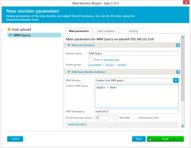With IPHost Network Monitor you can run WMI Power Management Capabilities monitoring of various devices in your network.
To create a WMI monitor for Power Management Capabilities, provide host name (it must be a Windows host) and specify custom WQL query:

Indicates the specific power-related capabilities of the logical device. The array values, 0="Unknown", 1="Not Supported" and 2="Disabled" are self-explanatory. The value, 3="Enabled" indicates that the power management features are currently enabled but the exact feature set is unknown or the information is unavailable. "Power Saving Modes Entered Automatically" (4) describes that a device can change its power state based on usage or other criteria. "Power State Settable" (5) indicates that the SetPowerState method is supported. "Power Cycling Supported" (6) indicates that the SetPowerState method can be invoked with the PowerState input variable set to 5 ("Power Cycle"). "Timed Power On Supported" (7) indicates that the SetPowerState method can be invoked with the PowerState input variable set to 5 ("Power Cycle") and the Time parameter set to a specific date and time, or interval, for power-on.
The Win32_MappedLogicalDisk class represents a network storage devices that are mapped as logical disks on the computer system. The instances returned for this class will be as follows. If user A is enumerating the instances, then the provider will look for a logon session of user A on that machine. If there is one (and only one) such logon session, then the provider will return the mapped drives of that session. If there is more than one session that user A has on the machine, then no mapped drive instances will be returned (since the provider has no reasonable way of deciding which session to use). If there are no sessions of user A running, and there is a locally logged on user B, then the provider will impersonate A and return the mapped drives of user B. This case supports the scenario of helpdesk wanting to see the instances of a locally logged on user. Again, if there is more than one session of user B running on the machine, then the provider has no way of deciding which to use. In this case no mapped drive instances will be returned.
IPHost Network Monitor is an advanced and easy tool for monitoring LAN and WAN networks, network servers, workstations and TCP/IP devices. Use IPHost Network Monitor to monitor your servers, domains, computers and devices.

